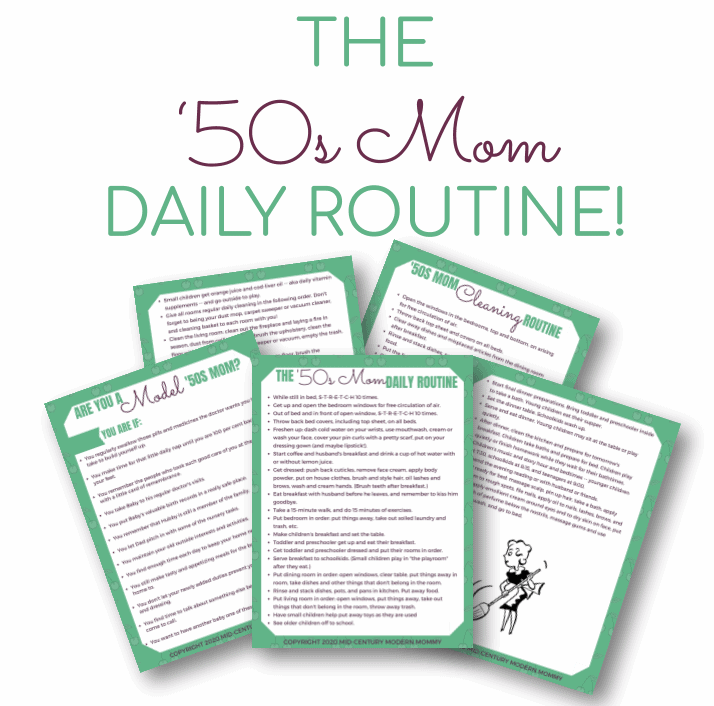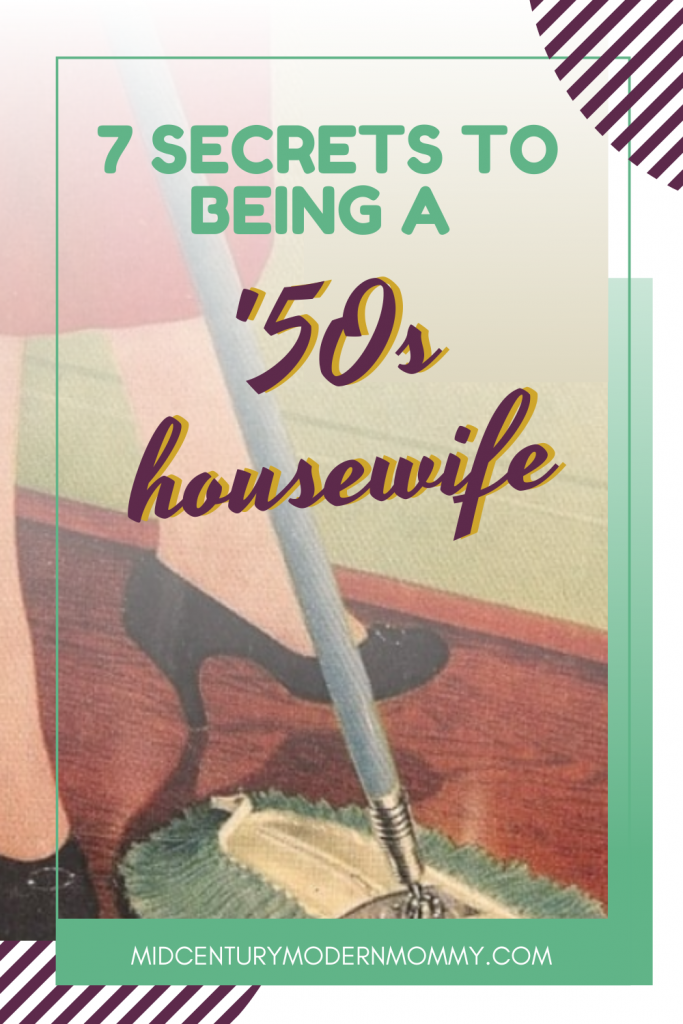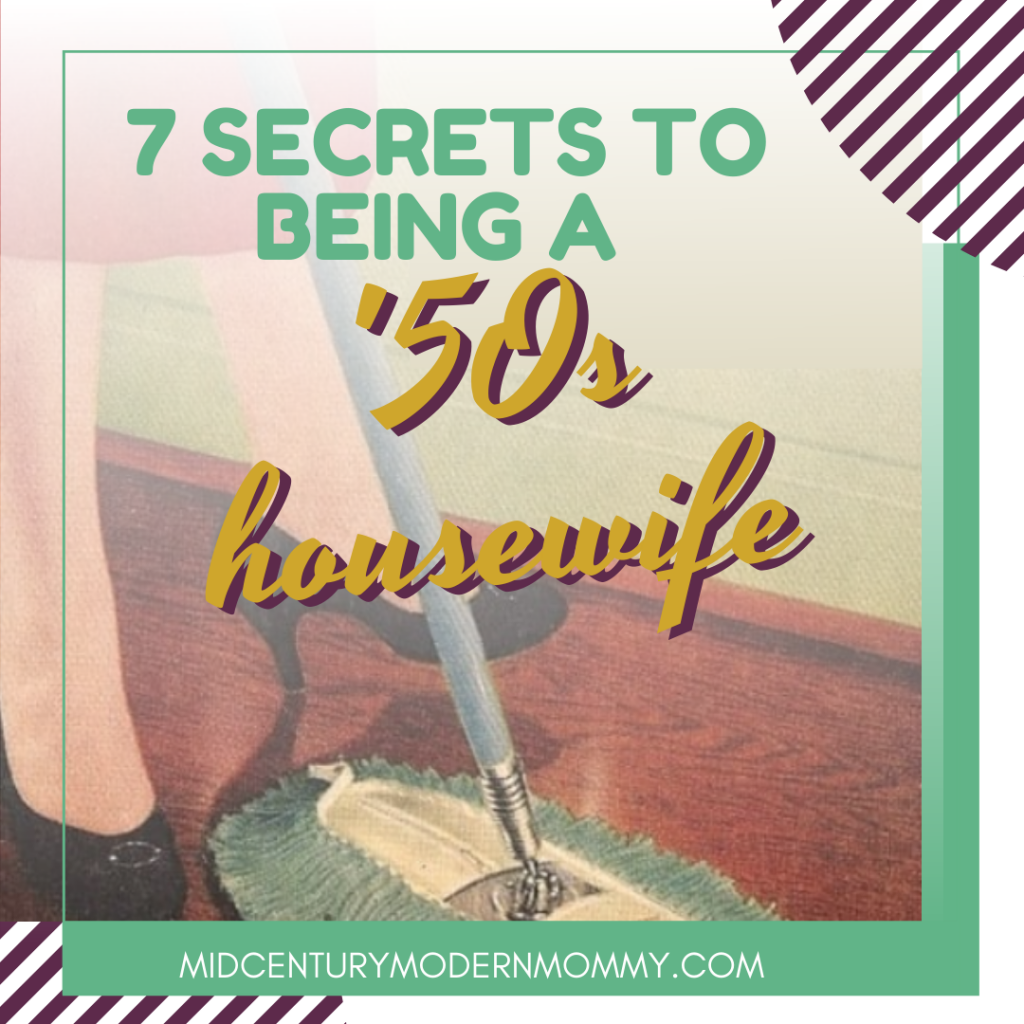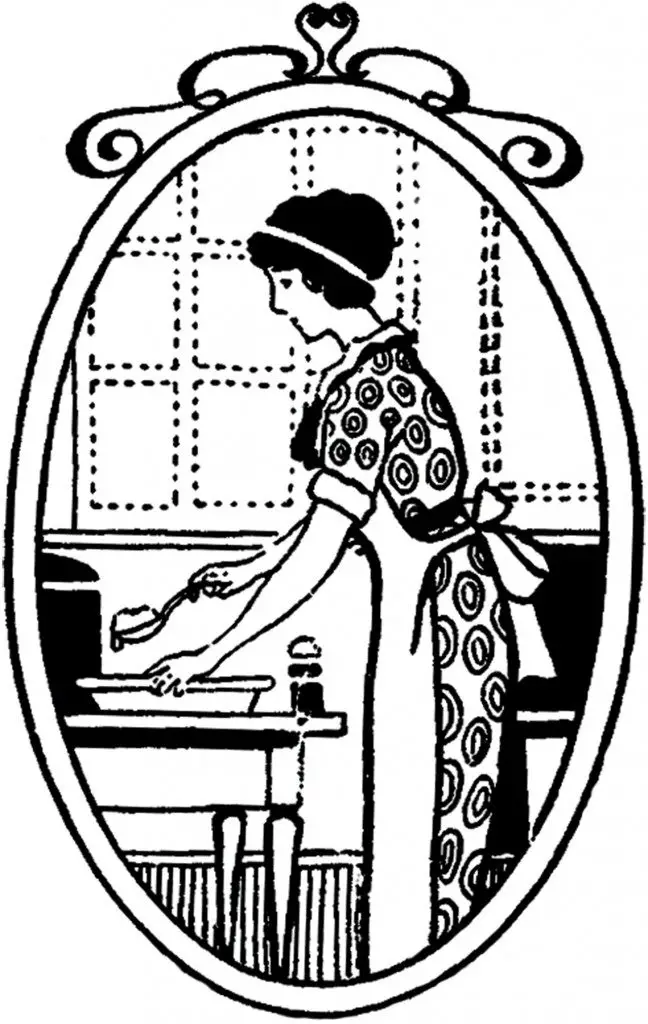When I was in high school, I loved old-fashioned things. I especially loved the resilient, feminine superwomen who were housewives in the 1930s, 40s, and 50s. When I married, and had children, I could not understand why it was so hard for me to achieve being a modern-day ’50s housewife! I didn’t know the first thing about what it took to be a homemaker! I read magazines and books, and I discovered 7 secrets of being a 50s housewife to help me be one, too.

Get Our Mid-Century Mom Daily Routine FREE!
- The '50s Housewife was a Mid-Century Minimalist
- The '50s Housewife was Organized
- The '50s Housewife Planned Ahead
- The '50s Housewife Acted Like a French Woman
- The '50s Housewife Took Pride in Her Work
- The '50s Housewife Trained Her Children
- The 50s Housewife Was Not a Stay-At-Home
- Being a Modern-Day 50s Housewife
This post contains affiliate links. If you click a link and make a purchase, I may receive, at no additional cost to you, a small commission. Find out more on my Disclosures page, and thank you so much for your support!
The ’50s Housewife was a Mid-Century Minimalist
A real ’50s housewife didn’t spend all her time cleaning. She cleaned more thoroughly than most women do today, but she spent less time tidying her house, because she had less stuff. Although consumption increased after World War II, the average household simply didn’t have as much stuff as we do know. In particular, children had fewer toys. The average American child today has 200 toys, and plays with 12 of them.
The number 1 secret to being a modern-day ’50s housewife is to declutter your house. And the best way to do this in true 50s housewife fashion is actually to use the Konmari method. Why? Because the KonMari method doesn’t only have you declutter, it teaches you to curate your style by asking, “Does this spark joy?” and “Do I want this in my life going forward?” And curating your style is very ’50s housewife.
By the way, this also applies to homeschool. The best form of homeschool for the modern-day 50s housewife is minimalist homeschool, which focuses on reading, writing, and arithmetic. Kids study math, then they read books and write about what they think, feel, and read. (They can also illustrate their writing, especially nice for visual learners!) This kind of back-to-basics, old-fashioned education is as minimalist as it gets.
The ’50s Housewife was Organized
“A place for everything and everything in its place” is an old-fashioned motto, but housewives from the Depression to the Baby Boom paid attention to the simple lesson from their grandmothers. Old decorating books recommended that you plan for storage and display from the very beginning of your housekeeping.
Every one of my mid-century housekeeping manuals begins with a section on management. And that section doesn’t just have schedules and budget guidelines, it also talks about organizing. As a modern-day ’50s housewife, your kitchen, laundry, and sewing rooms should all be meticulously organized for efficiency and beauty. Your attitude toward organizing will be passed on to your children — and if you have a love of organized spaces, they might, too!
And, honestly, it’s far more likely that 50s housewives would have swooned over the colorful beauty of #thehomeedit style that over the farmhouse look — but you do you, crackerjack! Personally, I love the look of Craftsman homes and Art Deco posters!
The ’50s Housewife Planned Ahead
The beginning of the “scientific housekeeping” movement, which had its heyday in the 1950s housewife era, began in the 1920s, under the same auspices and the “scientific management” movement in business and industry. The idea was that good management was necessary for the most effective and efficient workplace. And good management meant schedules and procedures.
America’s Housekeeping Book, published from the 1940s through the 1950s, begins with a section on planning your home and housekeeping. The first few chapters are all about management, especially planning. Planning the work, planning menus, planning for hospitality — her schedule even included changing daily for dinner, and two or three hours each week for beauty treatments like a facial and manicure.
If you want to be a modern-day 50s housewife, you need to make a schedule. You’ll also need a cleaning plan, a meal plan, and a self-care plan. You’ll also need schedules for your kids. Or, if you’re like me, you may want to just collect all the schedules and lists from vintage books and put the originals all together to have a REAL ’50s housewife schedule.

Get Our Mid-Century Mom Daily Routine FREE!
The ’50s Housewife Acted Like a French Woman
A constant stream of books about fascinating, feminine French female ways in the past 20 years is a reminder of how fabulous and enticing the ultra-feminine aesthetic can be! In Bringing Up Bebe, Pamela Drucker writes about how French women expect to look good and be sexy all the time. Even after they have babies, they expect to be back to “sexy” in just a couple of months.
Appearance, and being desirable to their husbands was important to ’50s housewives, also. Although books promoting desirability are often mocked today, the marriage advice about the importance of staying pretty, putting your husband first, and always considering his needs and wants as more important than your own was meant in complete seriousness at the time.
All this means that a modern-day mid-century mom or ’50s housewife should focus on self-care. Good health, a good figure, looking pretty, cleanliness, and stylish dress are all important parts of a ’50s housewife’ self-care routine. Create a plan for getting up early to dress and fix your hair and makeup. Workout during the day. Set your hair and bathe each evening. Also, make time each week for personal grooming tasks like hair removal and manicures.
It also means that the modern-day ’50s housewife focuses on her marriage rather than her kids as the most important part of the family. Try being open to intimacy whenever your husband suggests it, doing little things that speak his love language, and using the Good Wife’s Guide as a way to welcome your husband home in the evenings.
The ’50s Housewife Took Pride in Her Work
In Lessons from Madame Chic, Jennifer Scott talks about how her hostess made three-course dinners every night. Food was prepared for appearance as well as taste. And the apartment!
Mid-century modern housewives also took pride in having dinner ready on time, keeping their house company-ready, and acting as hostess for her husband.
A 50s housewife should find something in her housekeeping that brings her joy, and use it to inspire her homemaking. In general, this will fall into 5 different types: social, intellectual, domestic, creative, or civic. It may be a hobby, personality traits, or more self-care. When your own need for recreation is met, you’re more likely to enjoy your domestic work and your marriage.
The ’50s Housewife Trained Her Children
The 50s housewife didn’t parent her children. She raised them. In other words, she didn’t focus on giving them an idyllic childhood, but rather focused on training them up into productive, conscientious, capable citizens.
Of all the things modern-day 50s housewives miss, the most trying loss might be the loss of a society that allowed all the children in a neighborhood to play safely and act independently, with the full knowledge that every single adult would discipline them if needed. The social boundaries were there, and freedom came from staying within those boundaries.
Since we can no longer do this, old-fashioned child rearing can be much more difficult. But mid-century moms are resourceful, and through a careful use of chores, independent play, and old-fashioned discipline, you can still recreate these same results. This is another area where minimalist homeschooling can help. The main focus in a minimalist homeschool is teaching your children to be independent scholars, not dependent on watered-down, spoon-fed education. By requiring your children to take responsibility for their own learning, you are teaching them to be self-reliant.
The 50s Housewife Was Not a Stay-At-Home
The 50s housewife was a pillar of her community. Most of this comes from the fact that the epitome of the 50s housewife was the upper-middle-class suburban housewife, and the upper-middle-class women are the originators of charitable organizations.
One of the reasons that non-profit charities struggle so much in today’s economy is less about money and more about a lack of volunteers. Actually the same problem is faced in the home — it costs a LOT to do what women in the home do for “free.” When housewives contributed their time and energy, more charitable work could be done.
And it wasn’t just charity work. It was political work, educational work, organizing, helping at school and church, and even running a club. The 50s housewife was involved in her local community and her neighborhood.
As a modern-day 50s housewife, try to get to know your neighbors. Go to church (or temple, or whatever.) Volunteer at your child’s school (I prefer to run a homeschool co-op). Maybe even start a ladies’ club. Or have a weekly coffee klatch or bridge lunch. Get involved, make friends, and influence people!
Being a Modern-Day 50s Housewife
Being a mid-century mom and a 50s housewife is not like how the snarky, 50s housewife humor portrays it. It focuses on what is important, like taking care of yourself, putting your marriage ahead of your kids, and simplifying stuff in favor of experiences. It’s NOT about buying to much stuff, working yourself to death — or even being bored.
What do you think of being a ’50s housewife Let me know in the comments!






I love your blog! You’ve hit on the time period that many are trying to return to. It sounds like you read a lot. Some very interesting material here. I can’t wait to see what else you have to say.
Thank you! I have quite a few books from the early and mid-20th century, and I find that a lot of the information and advice is still very relevant and helpful! I am glad you stopped by!
I really enjoy your blog. I wish I knew women near me who were like-minded. I strive to live my best vintage life. I appreciate all of your content and will continue to read it!
Yes! It is really hard to find anyone else here. I have to find other vintage lifestyle enthusiasts online!